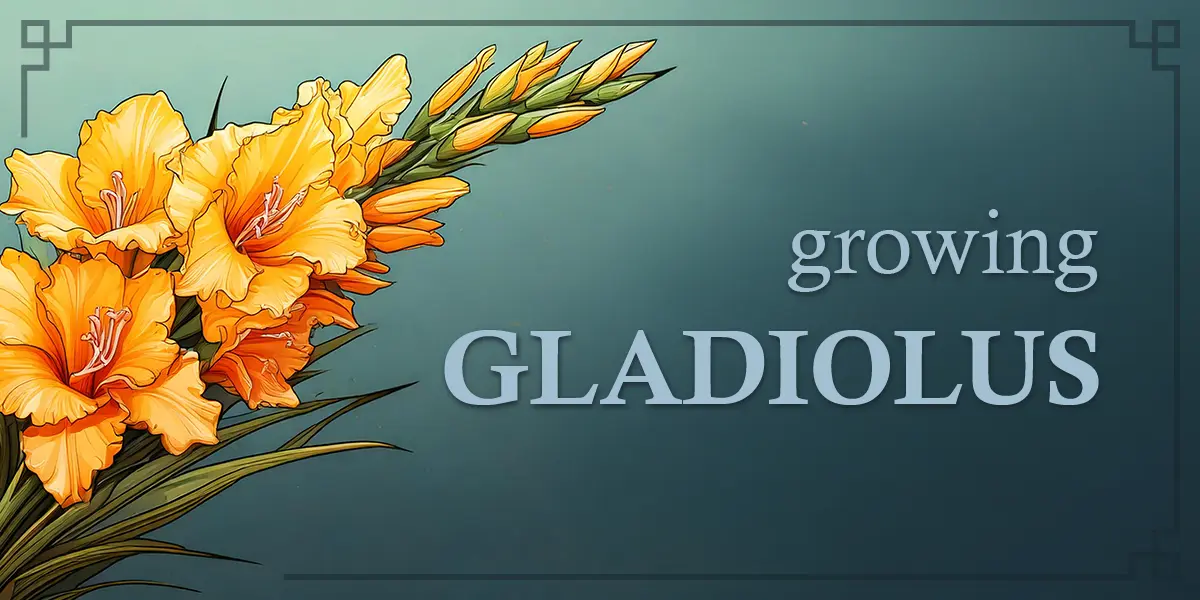Gladiolus is prized for its tall, striking flower spikes and vibrant hues. The plants are native to South Africa and the Mediterranean, where they flourish in warm temperatures and full sunshine. This makes them a natural for Southern California gardens.
The name “gladiolus” derives from the Latin word “gladius,” meaning sword, due to the flowers’ long, sword-like leaves. The flowers symbolize strength and moral integrity and often serve as centerpieces in bouquets and floral arrangements.
Gladiolus plants are perennials, meaning their corms return year after year if cared for. In Southern California’s balmy climate, they produce the most spectacular blooms in the growing season immediately after planting.
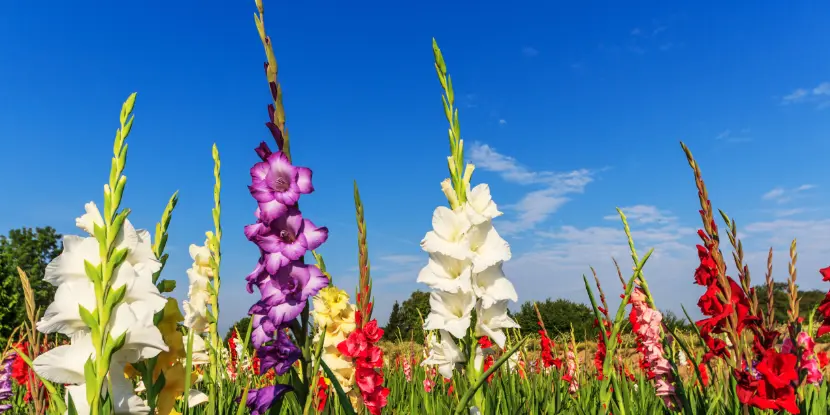
Some of the many colors of the gladiolus flower.
Popular Gladiolus Varieties
One reason gladioli are so beloved is their range of varieties and colors. These include:
Large Flowering Gladiolus
- Best for dramatic displays
- Grows up to 60 inches tall
- Includes varieties such as ‘Priscilla’ (white-pink-edged blooms)
Miniature Gladiolus
- Ideal for borders or pots
- Reaches around 12–18 inches high
- Includes varieties like ‘Atom’ (red with white edges)
Hardy Gladioli
- Perfect for cooler temperatures
- Can survive mild winters
- Varieties include ‘Gladiolus nanus’
- Reaches about 24 inches tall
Butterfly Gladiolus
- Attracts pollinators
- Grows up to 5 feet tall
- Includes varieties like ‘Butterfly Mix’ (pink, purple, and white blooms)
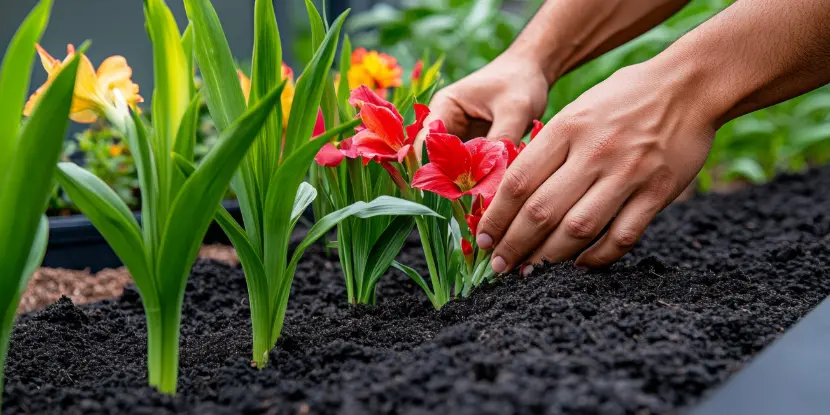
A gardener transplanting young gladiolus plants.
Optimal Growing Conditions
Light
- Gladioli prefer full sun.
- Choose a spot in your garden, balcony, or yard that receives at least 6 hours of direct sunlight daily.
Temperature
- Ideal daytime temperatures range between 65–80°F.
- Gladioli can tolerate Southern California’s heat, but extreme heat over 85°F may slow growth. Provide filtered shade during heat waves.
Soil
- Choose well-draining, slightly acidic to neutral soil (pH 6.0-7.0).
- Amend your soil with compost to improve drainage and nutrient content.
Propagating Gladiolus
You can propagate gladiolus using their bulb-like corms.
- Gently separate corms from the main plant after the foliage dies back.
- Store them in a cool, dry place before replanting in spring.
- This method produces genetically identical plants.
Pro Tip: To assure healthy growth, propagate only mature, healthy corms.
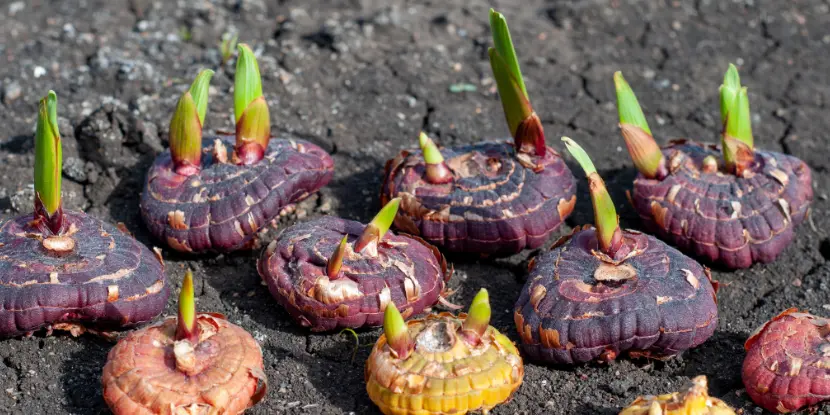
These sprouting gladiolus bulbs are ready to be transplanted.
Planting Gladiolus Step-by-Step
In Southern California, plant your gladiolus in early spring, after the last frost.
Planting in the Garden
- Gladiolus works well in flower beds, large containers, or raised garden plots.
- Dig the soil to a depth of about 12 inches to improve aeration, and mix in compost to boost nutrient levels.
- Plant each corm about 4–6 inches deep and space them 6 inches apart.
- plant new corms every 2 weeks from spring to early summer for staggered blooms.
- After planting, water the site thoroughly to settle the soil around the corms and kickstart growth.
- Gladiolus shoots should appear within 2–3 weeks.
- For larger varieties, insert stakes early to support the stems as they grow and prevent flopping.
Planting in Pots & Planters
- Choose a pot or planter at least 8 inches deep with suitable drainage holes.
- Fill it with well-draining potting soil, leaving about an inch of space at the top for watering.
- Plant corms as you would in the garden — 4–6 inches deep and spaced 6 inches apart.
- Water thoroughly after planting until excess water drains from the bottom of the pot.
- Place your pots in a sunny location and water regularly to keep the soil moist but not soggy.
- For added support, insert stakes or trellises into the pot before or after planting.
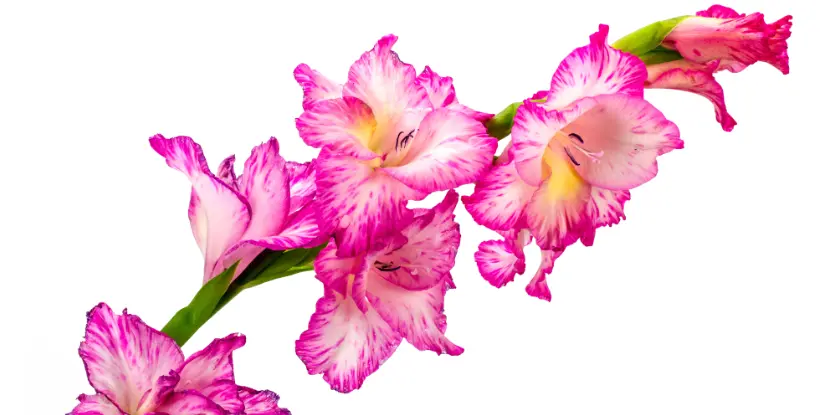
The spiking flowers of gladiolus plant.
Gladiolus Care
Once planted, gladiolus thrives with minimal ongoing maintenance.
Water
- Keep the soil consistently moist but not soggy.
- Water deeply once or twice weekly, especially during Southern California’s dry months.
Fertilizer
- Use a balanced fertilizer (10-10-10) every 2 weeks once the sprouts emerge.
- Stop fertilizing as the flowers bloom to avoid weakening the corms.
Pests & Diseases
Look out for the following common issues and how to handle them:
- Pests: Aphids, spider mites, and thrips are common gladiolus pests. Treat infestations with neem oil or insecticidal soap.
- Diseases: Gladiolus can develop fungal diseases like botrytis. To prevent this, ensure proper spacing and air circulation.
Pruning
- Remove spent flowers and withered foliage regularly to encourage continuous blooming.
- Cut back the entire plant when it dies back in the fall to promote healthy growth next spring.
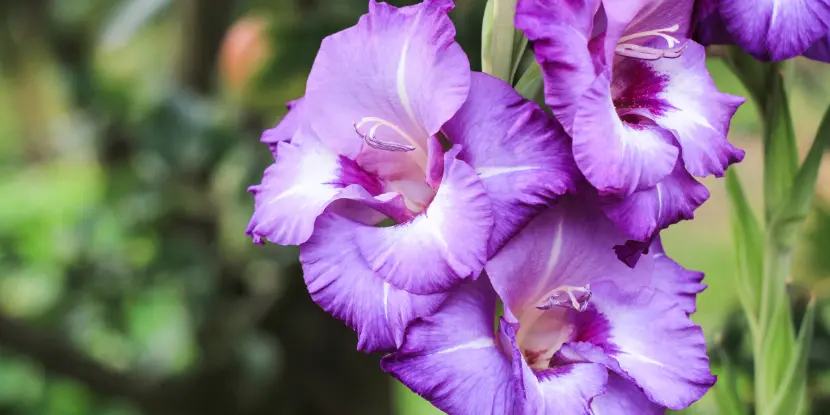
Closeup of purple gladiolus blossoms.
Harvesting & Storing Gladiolus Flowers
When to Harvest
- Wait until the first few flowers on a spike are open before cutting.
- Use sharp, clean scissors or shears to make a clean cut just above where the stem meets the foliage.
How to Store
- Place freshly cut stems in lukewarm water immediately.
- Store them in a cool, dark place for at least a few hours before arranging them in vases or bouquets.
- Place cut flowers in a refrigerator set to 33°F with high humidity to store them for longer periods.
- Change the water every few days and trim the stems at an angle each time to maintain freshness.
Additional Tips for Growing Gladiolus
- Don’t plant gladiolus in areas prone to strong winds. Their tall stems may break.
- Avoid overwatering, which can cause root rot and other fungal diseases.
- In colder climates, dig up corms in fall and store them in a frost-free location over winter before replanting in spring.
- Gladiolus is deer-resistant, making it an excellent choice for rural gardens.
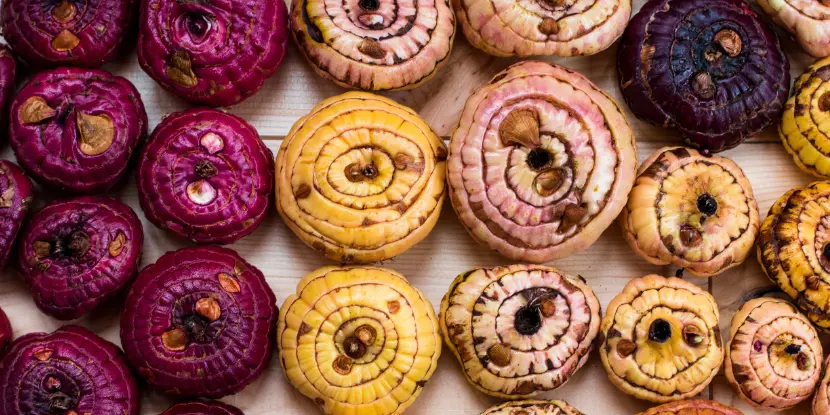
Gladiolus bulbs ready for winter storage.
FAQs: Gladiolus Care
Q: When should I plant gladiolus in Southern California?
Plant them in early spring after the last frost. Southern California’s mild winters mean you can start early in February or March.
Q: Do I need to dig up the corms in winter?
Yes, in colder regions, but Southern California gardeners don’t need to dig up corms for winter storage. However, mulching around the plants can provide extra insulation during rare frost periods.
Q: How long does it take gladiolus to bloom?
Gladiolus usually blooms about 10-10–12 weeks after planting, depending on the variety.
Q: How often should I water gladiolus during the summer?
During Southern California’s dry summer months, water gladiolus is used once or twice a week to keep soil moist but not waterlogged. Deep watering is better than frequent shallow watering to encourage strong root growth.
Q: Can I grow gladiolus indoors?
Yes, gladiolus can be grown indoors in pots if placed in a bright, sunny spot that receives at least 6 hours of sunlight daily. Ensure the pot has good drainage and use well-draining soil to prevent root rot.
Q: What companion plants pair well with gladiolus?
Gladiolus pairs beautifully with other summer-blooming flowers like zinnias, dahlias, and marigolds. These plants help create a vibrant garden while providing additional support for gladiolus stalks and attracting pollinators.
Q: How can I prevent thrips from damaging my gladiolus?
Inspect your plants regularly and remove any damaged foliage. Use insecticidal soap or neem oil as needed, and consider rotating the location of your gladiolus each year to reduce the chances of infestation.

